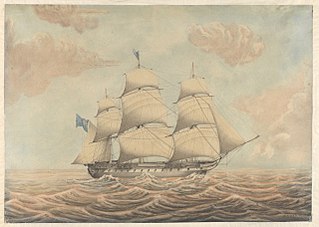
HMS Gloucester was a 74-gun, third rate Vengeur-class ship of the line built for the Royal Navy in the 1810s. She played a minor role in the Napoleonic Wars and was cut down into a 50-gun fourth rate frigate in 1831–32. The ship was converted into a receiving ship and broken up in 1884.

HMS Myrmidon was a 20-gun Hermes-class sixth-rate post ship built for the Royal Navy during the 1810s. She was commissioned in 1813 and was in the Mediterranean four years later. The ship was on the Africa Station in 1819 and was paid off three years later. Myrmidon was broken up in 1823.
HMS Valorous was a 20-gun Hermes-class post ship sixth-rate post ship built for the Royal Navy during the 1810s. She was placed in commission in 1821 for service abroad in the Caribbean and Newfoundland. Two of her captains were forced to resign their commands during this time and the ship was placed in reserve in 1826 until she was broken up in 1829.

HMS Thetis was a 46-gun Leda-class fifth-rate frigate built for the Royal Navy during the 1810s. She was first commissioned in 1823 and was assigned to the South America Station three years later. The ship was wrecked in 1830 off Cape Frio, Brazil, with the loss of 22 crewmen; most of her cargo of bullion was successfully salvaged.

HMS Arethusa was a 46-gun Leda-class fifth-rate frigate built for the Royal Navy during the 1810s. The ship was never commissioned and was converted into a lazarette in 1836. She was renamed HMS Bacchus in 1844 and was further converted into a coal hulk in 1851–52. The ship was sold for scrap in 1883.

HMS Melampus was a 46-gun modified Leda-class fifth-rate frigate built for the Royal Navy during the 1810s. Completed in 1820, she was not commissioned until 1845 for the South America Station and was converted into a store and receiving ship in 1855. The ship was briefly assigned as a coast guard ship before being paid off in 1858. Melampus was converted into a Roman Catholic chapel ship in 1866 and then became a store ship twenty years later. The ship was sold for scrap in 1906.
HMS Nereus was a 46-gun modified Leda-class fifth-rate frigate built for the Royal Navy during the 1810s. She was never commissioned and was converted into a store ship in 1843 for service in South America. The ship was sold for into civilian service in 1879.
HMS Thisbe was a 46-gun modified Leda-class fifth-rate frigate built for the Royal Navy during the 1820s. The ship was never commissioned and spent her entire career in reserve or on third-line duties. She was converted into a depot ship in 1850 and then into a floating church in 1863. Thisbe was replaced by a shore-based establishment, All Souls Chapel, in 1891 and sold for scrap the following year.
HMS Druid was a 46-gun Seringapatam-class fifth-rate frigate built for the Royal Navy during the 1820s, the name ship of her sub-class.

HMS Nemesis was a 46-gun Seringapatam-class fifth-rate frigate built for the Royal Navy during the 1820s, one of four ships of the Druid sub-class.

HMS Leda was a 46-gun Seringapatam-class fifth-rate frigate built for the Royal Navy during the 1820s, one of seven ships of the Druid sub-class.

HMS Stag was a 44-gun Seringapatam-class fifth-rate frigate built for the Royal Navy during the 1820s, one of three ships of the Andromeda sub-class.
HMS Seahorse was a 44-gun Seringapatam-class fifth-rate frigate built for the Royal Navy during the 1820s, one of three ships of the Andromeda sub-class. After completion in 1830, she was ordered to be converted into a steam-powered ship in 1845, but this did not happen for another decade.
HMS Forth was a 44-gun Seringapatam-class fifth-rate frigate built for the Royal Navy during the 1820s, one of three ships of the Andromeda sub-class. After completion in 1833, she was ordered to be converted into a steam-powered ship in 1845, but this did not happen for another decade.
HMS Sprightly was a 6-gun Nightingale-class cutter built for the Royal Navy during the 1810s. She was wrecked off the Isle of Portland in 1821.

HMS Talbot was a 28-gun Atholl-class sixth-rate frigate built for the Royal Navy during the 1820s.

HMS Lily was a 16-gun Racer-class brig-sloop built for the Royal Navy during the 1830s.
HMS Grecian was a sixteen-gun Acorn-class brig-sloop built for the Royal Navy during the 1830s.
HMS Persian was a sixteen-gun Acorn-class brig-sloop built for the Royal Navy during the 1830s.
HMS Medway's Prize was a 28-gun sixth rate taken by HMS Medway on 17 August 1704. She was registered as a Royal Navy Vessel on 6 September 1704. She was commissioned into the Royal Navy in 1705 for service in Home Waters then Jamaica. She was sold in late 1713.











